The facts of crucifixion
- ROBERT GIDLEY
This article is disturbing. There is nothing pleasant about crucifixion.
 However, having an understanding of crucifixion helps us understand what Jesus went through on the day of his death. This article is based on various articles written by medical doctors, including a study by the Mayo Clinic published in the Journal of the American Medical Association in 1989.
However, having an understanding of crucifixion helps us understand what Jesus went through on the day of his death. This article is based on various articles written by medical doctors, including a study by the Mayo Clinic published in the Journal of the American Medical Association in 1989.
Crucifixion probably started first with the Persians (what is modern day Iran). Initially, the victim was suspended to keep their feet from touching holy ground. The Phoenicians, traders to many lands, seem to have also acquired the practice and probably spread it to other cultures, including the Greeks.
Alexander the Great (a Greek) introduced the practice to Carthage, where it was picked up by the Romans. The Romans started using it around the time Jesus was born.
The Romans perfected crucifixion as a punishment designed to maximize pain and suffering. It wasnt about killing somebody — it was about killing somebody in a really horrible way. Someone who was crucified suffered the maximum amount of pain.
Crucifixion was also the most disgraceful form of execution. It was usually reserved for slaves, foreigners, revolutionaries, and vile criminals. The only time a Roman citizen was ever crucified was for desertion from the army.
What was flogging?
Flogging, or scourging, was done before every crucifixion. The scourging was intended to bring a victim to a state just short of death.
Also, it hurt. A lot.
The whip had iron balls tied a few inches from the end of each leather thong on the whip. Sometimes, sharp sheep bones would be tied near the ends. The iron balls would cause deep bruising, while the leather thongs would cut into the skin. The sheep bones would hasten the process of cutting into the skin. After a few lashes, the skin would be cut through, and the muscles would begin to be cut. Blood loss was considerable, and the pain would probably have put the victim in a state of shock.
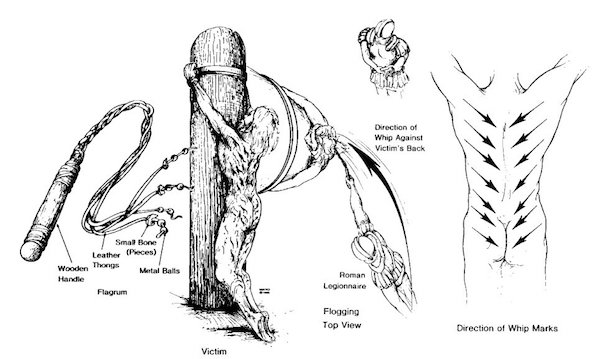
What was a typical crucifixion like?
After the flogging, the victim would carry his own cross bar (called a patibulum) from the flogging area inside the city to the crucifixion area outside of the city walls. The crucifixion area was always outside the city, because the process was horrible and disturbing to citizens.
The upright part of the cross (the stipe) was permanently mounted in the crucifixion area. The part that the victim carried was the cross bar, weighing in at 75 to 125 pounds. The cross bar would be balanced on the victims shoulders, and their arms would be tied to the crossbar. In this position, if the victim tripped or fell, they could not use their arms to break their fall, and they would likely fall face first into the ground.
The victim was escorted by a Roman guard (probably a centurion and several soldiers), who were responsible for guarding the victim until his death. One of the soldiers would display a sign with the crime written on it.
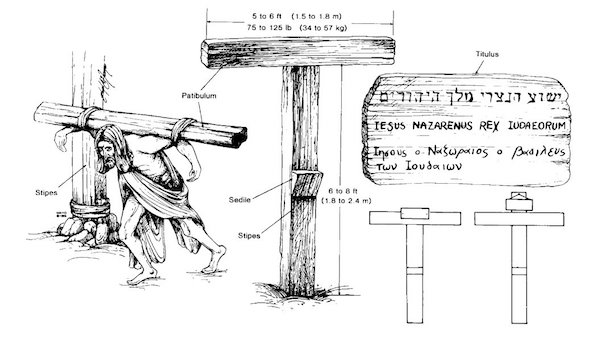
Once the crucifixion area was reached, the victim would be offered a drink of wine mixed with myrrh to act as a mild pain killer. The drink was a charitable service performed by an association of women in Jerusalem.
Then they offered him wine mixed with myrrh, but he did not take it. - Mark 15:23
The victim would then be nailed to the cross bar. The nails would be driven through the wrists, not through the palms, as these would not support the body weight.
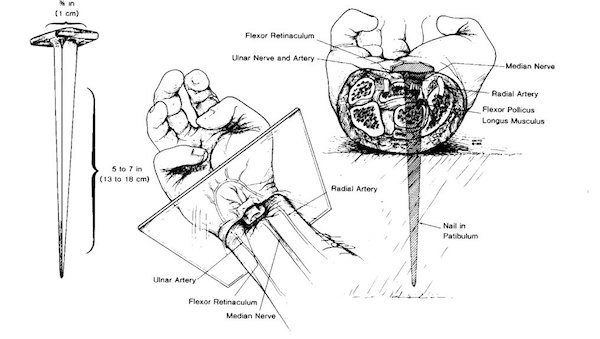
The cross bar would be raised and placed on the upright post, where the victims heels would be nailed to the post.
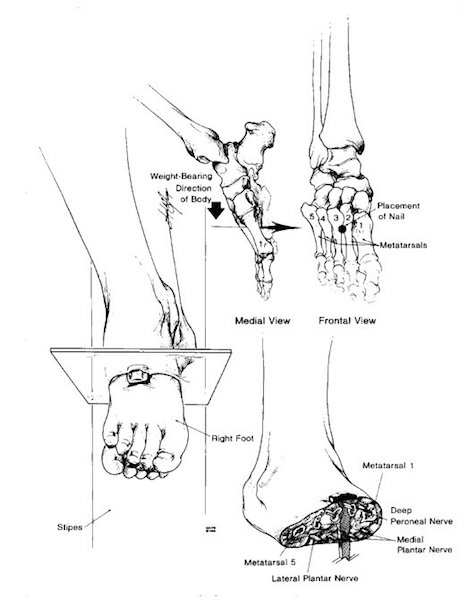
Once crucified, a victim would live for a period ranging from a few hours to a few days. How long he lived depended mostly on how severe the scourging was.
If no one claimed the body, it would be left on the cross to be eaten by predatory animals. The family could, however, claim the body for burial. In this case, a Roman soldier would pierce the chest with a sword or spear to make sure the victim was dead.
What actually kills the victim?
The initial scourging would weaken the victim, cause massive blood loss, and probably induce shock. By the time the victim had carried thecross bar to the crucifixion area, he would be exhausted.
Once up on the cross, the victim would have his body weight suspended by their arms. In this position, it is difficult to completely exhale. The victim could take shallow breaths for a while, but eventually would be forced to push himself up to take a full breath.
At this point three things happen:
- The victim's weight is now fully supported by his feet. The nails through the feet would be likely to hit two major nerves running through the area. The result would be excruciating pain in the legs.
- The nails in the wrists would be likely to pierce the main nerve running through the arm. As the victim pushed up to breath, the wrists would rotate against the nail, irritating the nerves and causing intense pain in the arms. Some authorities also believe that the crucifixion position would dislocate the shoulder or elbow. Any movement would aggravate the pain from these injuries.
- The wounds on the victims back from the scourging would push up against the rough part of the centerpiece. This would tend to re-open the wounds, leading to more pain and blood loss.
This combination of pain would quickly force the victim to lower himself back down. Eventually, the victim would no longer be able to raise himself up and would suffocate. The shock from blood loss due to the scourging would hasten this process.
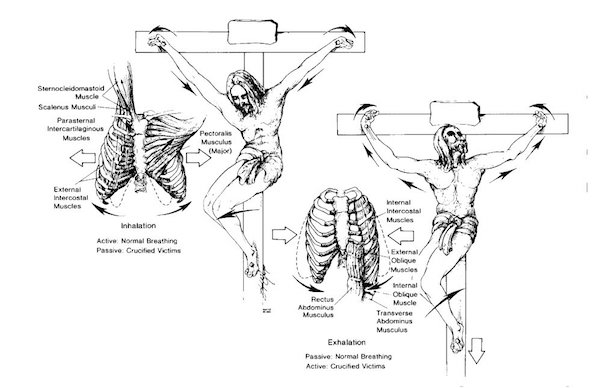
In some cases, the victims legs were broken to finish him off. This would prevent the victim from being able to raise himself up and hewould suffocate in a matter of minutes.
Specifics of Jesus crucifixion
Jesus crucifixion mostly followed the standard procedure, although there were some differences. These differences help account for the fact that he died after a relatively short period of time on the cross.
And being in anguish, he prayed more earnestly, and his sweat was like drops of blood falling to the ground. - Luke 22:44
There is a condition called hemohidrosis or hematidrosis which occurs in people under extreme physical or emotional stress. The blood vessels in their sweat glands rupture and leak blood into their sweat. The effect is one of sweating blood. Several authorities believe that this is a plausible explanation for what happened to Jesus.
Although the loss of blood would not be significant, it shows that he was under extreme stress, which would have weakened him physically.
The men who were guarding Jesus began mocking and beating him. - Luke 22:63
Then some began to spit at him; they blindfolded him, struck him with their fists, and said, Prophesy! And the guards took him and beat him. - Mark 14:65
Then they spit in his face and struck him with their fists. Others slapped him - Matt 26:67
When Jesus said this, one of the officials nearby struck him in the face. Is this the way you answer the high priest? he demanded. - John 18:22
Before the scourging and crucifixion, Jesus was beaten by his guards, which would weaken him. In addition, he would have had no sleep that night, and walked back and forth from trial to trial.
A certain man from Cyrene, Simon, the father of Alexander and Rufus, was passing by on his way in from the country, and they forced him to carry the cross. - Mark 15:21
As they were going out, they met a man from Cyrene, named Simon, and they forced him to carry the cross. - Matt 27:32
As they led him away, they seized Simon from Cyrene, who was on his way in from the country, and put the cross on him and made him carry it behind Jesus. - Luke 23:26
Typically, a prisoner carried his own cross to the crucifixion site. The fact that Simon was pressed into carrying Jesus cross suggests that Jesus was too weak to carry his own cross.
It was Preparation Day (that is, the day before the Sabbath). So as evening approached, Joseph of Arimathea, a prominent member of the Council, who was himself waiting for the kingdom of God, went boldly to Pilate and asked for Jesus body.
Pilate was surprised to hear that he was already dead. Summoning the centurion, he asked him if Jesus had already died. - Mark 15:42-44
Since the Jewish Sabbath would begin at Sunset, it was important that the bodies not be left up, as Jewish law required that they be buried by the Sabbath.
Note that Pilate is surprised that Jesus is already dead.
Now it was the day of Preparation, and the next day was to be a special Sabbath. Because the Jews did not want the bodies left on the crosses during the Sabbath, they asked Pilate to have the legs broken and the bodies taken down.
The soldiers therefore came and broke the legs of the first man who had been crucified with Jesus, and then those of the other. - John 19:31-32
As mentioned earlier, breaking the legs of a crucified person would cause suffocation within minutes, because they would not be able to raise themselves up to breath.
But when they came to Jesus and found that he was already dead, they did not break his legs. Instead, one of the soldiers pierced Jesus side with a spear, bringing a sudden flow of blood and water. - John 19:33-34
Again, this was typical crucifixion practice — to stab the victim to make sure he was dead before releasing him to relatives.
The water that John describes as flowing is probably serous pleural and pericardial fluid — fluid that would build up from shock and blood loss. This fluid would tend to accumulate in the chest cavity and lungs.
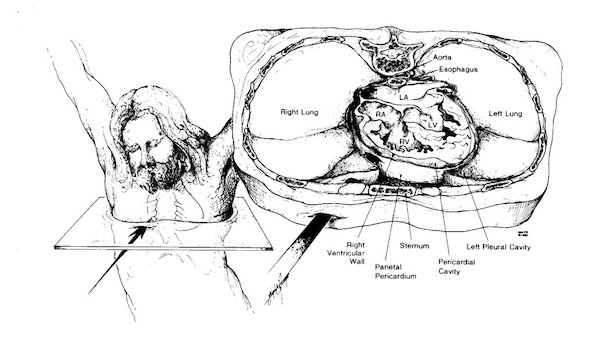
Short bits
A jar of wine vinegar was there, so they soaked a sponge in it, put the sponge on a stalk of the hyssop plant, and lifted it to Jesus lips. - John 19:29
The second drink, which He accepts moments before His death, is described as a wine vinegar. Two points are important to note. The drink was given on the stalk of a hyssop plant." Remember that these events occurred at the Feast of the Passover. During this feast, (Exod 12:22) hyssop was used to apply the blood of the Passover lamb to the wooden doorposts of the Jews.
 I hope you appreciated this piece. Before you move on, please consider taking the step of supporting CERC's mission with just $3.
I hope you appreciated this piece. Before you move on, please consider taking the step of supporting CERC's mission with just $3.
When you Google the answer to a question about faith and morals or current events in the Church, you often have to wade through dozens of misleading secular articles before finding a reliable source. CERC will give you faithful, reliable, well-reasoned answers to your questions—with just one click.
CERC is entirely reader supported. Around the world, readers can access CERC's free resources because of people like you. You give us the ability to provide the truth unfettered by algorithm censorship and secular-favored rankings.
Please consider supporting us just once with $3, or better yet, become a Guardian of Truth and support us every month with a little more. Thank you.
J. Fraser Field
Founder of CERC

Acknowledgement
Robert Gidley. "The facts of crucifixion." The Cross Reading (Lent, 2000).
The Cross Reading, is a quarterly publication of Holy Cross (Episcopal) Church in Redmond, Washington.
This article is reprinted with permission from the author. You may reprint this article as long as you don't charge people for it, and you send a copy to robert@robertgidley.com.
The Author
Robert Gidley belongs to All Saints Episcopal Church in Redmond, Washington, where he also works as a Technical Writer. He has four computers, two cats, and one wife.
Copyright © 2000 Robert Gidley

